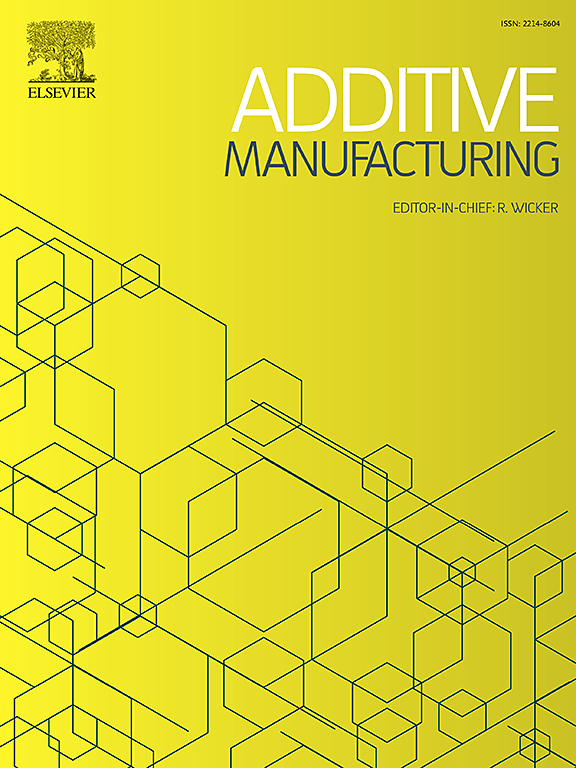基于增材制造的碳纤维增强聚合物复合材料挤压过程中纤维断裂的缓解研究
IF 11.1
1区 工程技术
Q1 ENGINEERING, MANUFACTURING
引用次数: 0
摘要
建立了一种计算流体力学和离散元法(CFD-DEM)耦合模型,用于表征材料挤压增材制造(MEX AM)中非牛顿流体与柔性纤维之间的多相流动相互作用。通过系统研究碳纤维与熔融聚合物在挤压沉积过程中的多相流动动力学,揭示了传统MEX AM工艺中碳纤维的断裂机理。结果表明,受边界壁和有限空间的约束而产生的高接触密度的稳定纤维结构是引起纤维变形甚至断裂的巨大机械力的关键因素。针对长碳纤维增强复合材料的沉积,提出了两种优化方案,即增大栅格高度和调整喷嘴进料角,以减轻纤维受到的巨大机械力。通过纤维变形量、纤维断裂量、纤维取向分布等关键性能参数对优化效果进行了定量评价。研究发现,调整NFA在改善纤维取向的同时,还能有效地减少纤维断裂。最后,通过实验验证了调整NFA的有效性。本研究为开发和优化用于打印长不连续碳纤维增强聚合物复合材料的MEX增材制造系统建立了数值框架,为在保持纤维取向均匀性的同时减少纤维断裂提供了见解。本文章由计算机程序翻译,如有差异,请以英文原文为准。
On the mitigation of the fiber breakage in material extrusion based additive manufacturing of carbon fiber reinforced polymer composites
A coupled computational fluid dynamics and discrete element method (CFD-DEM) model has been developed to characterize multiphase flow interactions between non-Newtonian fluid and flexible fiber in material extrusion additive manufacturing (MEX AM). The breakage mechanisms of carbon fibers in conventional MEX AM process are revealed through systematic investigation of the multiphase flow dynamics between carbon fibers and molten polymer during extrusion deposition. The results demonstrate that the stable fiber structure with high contact density arising from constraints of boundary wall and confined space serves as a critical factor inducing substantial mechanical forces that leads to fiber deformation or even breakage. Two optimization cases for the deposition of long carbon fiber reinforced composites have been developed, i.e., enlarging raster height and adjusting nozzle feeding angles (NFA) to mitigate substantial mechanical forces on fibers. The optimization efficacy has also been quantitatively evaluated through critical performance parameters including fiber deformation magnitude, fiber breakage content and fiber orientation distribution. It is found that adjusting NFA yield excellent performance in concomitantly mitigating fiber breakage while improving the fiber orientation. Finally, experimental observations confirm the effectiveness of the adjusting NFA. This study establishes numerical framework for the development and optimization of MEX AM systems for printing long discontinuous carbon fiber reinforced polymer composites, providing insights for mitigating fiber breakage while maintaining uniformity of the fiber orientation.
求助全文
通过发布文献求助,成功后即可免费获取论文全文。
去求助
来源期刊

Additive manufacturing
Materials Science-General Materials Science
CiteScore
19.80
自引率
12.70%
发文量
648
审稿时长
35 days
期刊介绍:
Additive Manufacturing stands as a peer-reviewed journal dedicated to delivering high-quality research papers and reviews in the field of additive manufacturing, serving both academia and industry leaders. The journal's objective is to recognize the innovative essence of additive manufacturing and its diverse applications, providing a comprehensive overview of current developments and future prospects.
The transformative potential of additive manufacturing technologies in product design and manufacturing is poised to disrupt traditional approaches. In response to this paradigm shift, a distinctive and comprehensive publication outlet was essential. Additive Manufacturing fulfills this need, offering a platform for engineers, materials scientists, and practitioners across academia and various industries to document and share innovations in these evolving technologies.
 求助内容:
求助内容: 应助结果提醒方式:
应助结果提醒方式:


